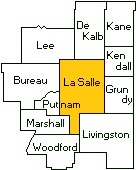
The people that made up the population of Manlius
township were Abner Stebbins, who came from New York State. He was a bachelor
who walked all the way. A few years later Abdol Stebbins came from New York
state in 1835. He drove an ox team bringing his wife and ten children with him.
Mr. Richey came in 1831 and Joseph Brumbach in 1832. Lowell Kimball came in
1833. David Olmstead and Mr. Linderman came in 1834. All these settlers broke
and drove oxen.
These people
broke up the sod with a wooden plow. These plows would plow a furrow from
sixteen to thirty inches wide and just a few inches deep because they found out
that shallow plowing was the best because the sun could get at the roots of the
sod and kill it. Plowing with these kinds of plows was hard work. They hitched
five and sometimes six yoke of oxen to one plow.
After the new sod was
turned over they cut a gash in it with an ax and dropped in the seed corn. They
covered it up with their feet and then stepped on it. Sometimes this would make
a good crop and sometimes it would not owing to the season.
Soon their
cribs were so full they were bulging out with corn. They fed all they could to
the cattle and hogs till they were fat and sleek. At last they found out it
would be necessary to haul the corn to some city and sell it. The nearest place
they could go was Chicago.
Some of the farmers would join together and
haul it in wagons. Instead of sacking it they put a sheet in the wagon and
shoveled in the corn. They started out with two or three yoke of oxen on one
wagon. They travelled all day and at night they stopped.
Sometimes they
would herd the oxen taking turns. They would also tie them to a stake driven
into the ground by a long rope so they could eat grass.
The next day
they started out again. Sometimes they would come to a river. If it was high
they had to wait for it to go down because there were not any bridges at that
time. While they were waiting they would pitch horseshoes or play other games.
These trips sometimes took five to ten days and sometimes two weeks. When they
got there they would bring back lumber and food.
The second year they
put in wheat. This made crops that averaged fifty bushels to the acre. They went
to Chicago with wheat this time. They brought back the things they needed.
Sometimes they would go twice a year with the grain. Soon they thought they
could raise and fatten cattle because they thought they could walk to Chicago
better than they could haul the grain. After the years went on better farm tools
were invented until now we have big plows and tractors and all kinds of
cultivators.
Each farmer soon planted a few fruit trees on a small spot
of ground.
The first apples in Rutland Township were on the farm of
Mathias Long. The first apples in Manlius township were on a tree planted by Mr.
Rickey and stood about three rods west of the residence of Mr. Long the
Universalist minister in Marseilles, (known as the old McCanna place). Joseph
Brumbach raised the first peaches in either Rutland or Manlius townships in
1838. Abdol Stebbins brought the seed from New York State. Currants were brought
in the county from Mackinaw by Mr. Parr who owned the first frame house.
Wheat was the main crop in the county until 1850, when the chinch bugs got
to be so thick they could not raise wheat very well without it being destroyed
by these bugs. After that they had more corn and it became the main crop.
The first train of cars that ran in the county was in September in 1852.
These trains ran on wooden tracks. Besides traveling in a few trains they had
stage coaches. The fare on Frink's and Bingham's stage coaches was five dollars
from Chicago to Ottawa. Every passenger was expected to carry a rail to pry the
coach out of mudholes and sloughs.
The first schoolhouse in Manlius
Township stood near George Bosworth's home. The first in Rutland Township stood
near Sam Milliken's farm. Miss Parker, who became afterwards Mrs. Lamphier was
the first school teacher in Manlius township. Mr. Lamphier soon became the
second school teacher in Manlius township. Mary Cetis, who became the wife of
Mancell Talcott, the old time millionaire of Chicago, was the third school
teacher of Manlius township.
The making of farms, homes, roads and
orchards out of the barren prairie made it a more civilized State in which we
live now.
Extracted 06 Jun 2015 by Norma Hass from Stories of Pioneer Days in La Salle County, Illinois, by Grammar Grade Pupils, published in 1932, page 79.
Extracted 08 Nov 2018 by Norma Hass from Stories of Pioneer Days in La Salle County, Illinois, by Grammar Grade Pupils, published in 1932, page 80.
| Lee | DeKalb | Kane |
| Bureau |
 |
Kendall |
| Putnam | Grundy | |
| Marshall | Woodford | Livingston |

